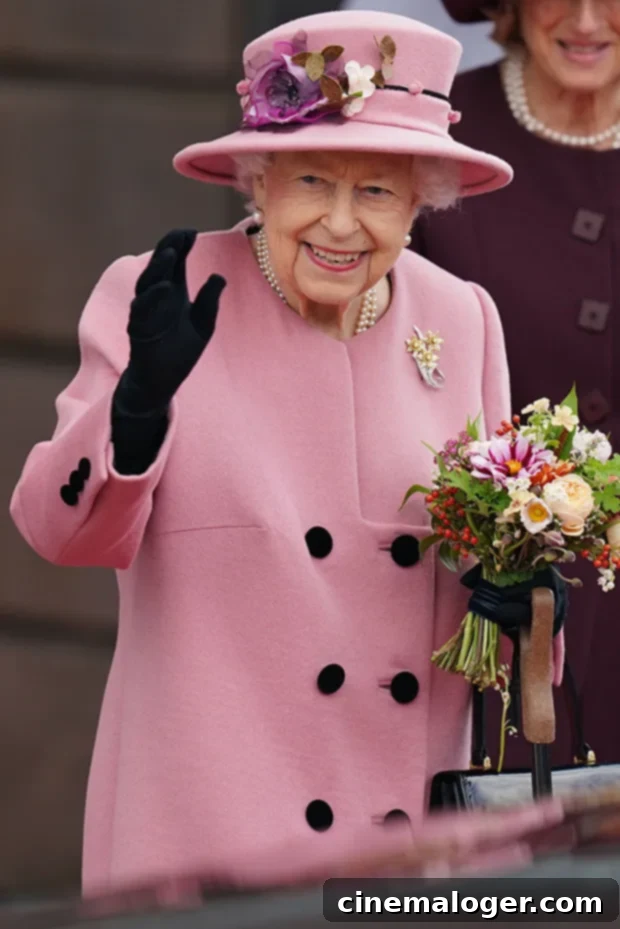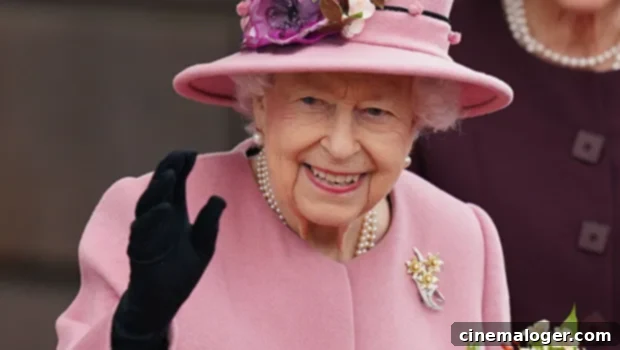Queen Elizabeth II Confirmed Alive: Buckingham Palace Dispels Death Hoax Amidst COVID-19 Recovery
Amidst a whirlwind of alarming reports, Buckingham Palace has definitively confirmed that Her Majesty Queen Elizabeth II is very much alive and well, effectively dispelling widespread death hoaxes that circulated on February 22. The official confirmation arrived on February 23, putting to rest a torrent of speculation and concern that had gripped the United Kingdom and the Commonwealth nations. This crucial update came with the revelation that the monarch had held an audience with U.K. Prime Minister Boris Johnson, serving as undeniable proof of her continued health and engagement in her royal duties.
The false claims, which had caused significant alarm across global media and social platforms, were vehemently contradicted by official sources. Buckingham Palace, the primary source of information regarding the British Royal Family, revealed to CNN on Wednesday, February 23, that Queen Elizabeth II had conducted a telephone audience with Prime Minister Boris Johnson from her residence at Windsor Castle. This important engagement occurred less than 24 hours after a sensational and ultimately erroneous report by Hollywood Unlocked boldly asserted that the 95-year-old sovereign had passed away, triggering a frantic search for official verification.
The audience with Prime Minister Johnson is a long-standing constitutional tradition, usually held in person. However, a royal source further informed CNN that the planned in-person meeting had been transitioned to a virtual format, specifically a phone call, in adherence to prevailing government guidelines. This adaptation underscored the palace’s commitment to prioritizing safety and public health while ensuring the continuity of essential state functions, even amidst the Queen’s recent health recovery.
The Genesis of a Viral Death Hoax
The unfounded rumors of Queen Elizabeth II’s demise originated from an exclusive report published by Hollywood Unlocked on Tuesday, February 22. The entertainment news outlet claimed that “sources close to the Royal Kingdom” had divulged the shocking news of the Queen’s passing. The report went on to allege specific details, stating, “She was scheduled to attend the wedding of British Vogue editor Edward Enninful, but was found dead.” The sensational nature of these claims, coupled with the immediate lack of official denial, quickly sent shockwaves across the internet. Social media platforms, in particular, erupted into a frenzy as concerned citizens and royal enthusiasts alike grappled with the news, desperately seeking clarification and expressing their disbelief and sorrow.
This report gained traction partially due to a prior announcement from Buckingham Palace just days earlier. On Sunday, February 20, the palace had confirmed that Her Majesty Queen Elizabeth II had tested positive for COVID-19. At the time, the official statement indicated that she was “experiencing mild cold-like symptoms” but was expected “to continue light duties at Windsor over the coming week.” This context, unfortunately, created a fertile ground for misinformation, as the public was already aware of her recent health challenges, making the death hoax seem plausible to some without immediate official refutation.
The Hollywood Unlocked report further fueled the speculative fire by mentioning that The Queen had “canceled her planned virtual engagements [on Tuesday] as she continued to suffer from the ‘mild Covid-19 symptoms’.” This detail, while potentially true regarding canceled engagements, was then juxtaposed with the dramatic claim of her death, leaving readers in a state of confusion and heightened anxiety. The report offered no further verifiable details about her alleged death, relying solely on unnamed sources and contributing to the rapid spread of unsubstantiated information across global news feeds.
Queen Elizabeth II’s Resilient Recovery and Return to Duty
Fortunately, the official response from Buckingham Palace swiftly brought an end to the speculation. The confirmation of her audience with Prime Minister Boris Johnson served as irrefutable evidence that Her Majesty was not only alive but actively engaged in her responsibilities as monarch. This reassuring update allowed millions around the world to breathe a sigh of relief, dispelling the unfounded reports that had caused significant distress.
The incident highlighted the inherent vulnerability of public figures, particularly those as revered as Queen Elizabeth II, to the rapid spread of misinformation in the digital age. Despite her advanced age of 95 and her recent bout with COVID-19, the Queen has consistently demonstrated remarkable resilience and an unwavering commitment to her duties. Her ability to hold a constitutional audience, even if by phone, so soon after a positive COVID-19 diagnosis, speaks volumes about her enduring dedication and recovery.
The palace’s initial statement on her COVID-19 diagnosis had been carefully worded to reassure the public that her symptoms were mild and that she would continue with light duties. This transparency, while intended to manage expectations and prevent alarm, inadvertently left a window open for less scrupulous outlets to exploit. However, the subsequent official confirmation of her audience with the Prime Minister quickly closed that window, demonstrating the monarchy’s effective strategy in countering false narratives with verifiable facts and actions.

The Importance of the Prime Minister’s Audience
The weekly audience between the monarch and the Prime Minister is a cornerstone of the British constitutional monarchy. This private meeting serves as a crucial channel for the Prime Minister to update the sovereign on government matters, and for the monarch to offer counsel and receive information, all within the bounds of constitutional impartiality. The mere fact that this audience took place, regardless of its virtual format, was the most definitive and public statement Buckingham Palace could make regarding the Queen’s health and continued capacity to govern.
The decision to hold the audience via telephone from Windsor Castle, rather than in person, was a pragmatic one, reflecting the ongoing adherence to public health guidelines, especially pertinent given the Queen’s recent COVID-19 diagnosis. This adaptation showcased the flexibility of the monarchy in upholding its traditional duties under challenging circumstances. It sent a clear message that while precautions were being taken, the essential functions of state were proceeding without interruption, reinforcing stability and continuity in governance.
For many, seeing or hearing about the Queen performing such a vital duty was not just a relief but a powerful symbol of her resilience. It reassured a concerned public that the reports of her death were baseless and that their long-reigning monarch, the head of state for the United Kingdom, Northern Ireland, Canada, Australia, and New Zealand, was still at the helm. The rapid succession of the false report and the official confirmation also underscored the palace’s efficiency in addressing critical public concerns.
Reflecting on Misinformation and Media Responsibility
This incident serves as a stark reminder of the perils of misinformation, particularly in an era dominated by rapid digital communication. The speed at which an unverified report can spread globally and cause widespread distress highlights the critical importance of media literacy and the need for individuals to scrutinize sources before accepting information as fact. Reliable, official sources, such as Buckingham Palace, remain the only authoritative voices for sensitive news concerning the Royal Family.
The public’s immediate concern and outpouring of grief on social media following the *Hollywood Unlocked* report demonstrated the deep affection and respect many hold for Queen Elizabeth II. This emotional reaction further emphasized the responsibility news organizations bear in verifying information rigorously before publication, especially when dealing with such globally significant figures. The damage caused by false reporting, even if swiftly corrected, can be considerable, ranging from public anxiety to a erosion of trust in media institutions.
As the world continues to navigate the complexities of digital news, this episode involving Queen Elizabeth II’s alleged death offers a crucial case study. It underscores the importance of critical thinking, the reliance on established and credible news channels, and the inherent dangers of viral, unconfirmed content. Ultimately, the swift and transparent response from Buckingham Palace was instrumental in restoring calm and ensuring that accurate information prevailed.
The Platinum Jubilee and Enduring Legacy
The false report of her death came at a particularly significant time, as Queen Elizabeth II is currently celebrating her 70th year on the throne, a historic milestone known as the Platinum Jubilee. This unprecedented reign makes her the longest-serving British monarch and a symbol of stability and continuity through decades of immense global change. The preparations for widespread Platinum Jubilee celebrations throughout 2022 are well underway, aiming to honor her unparalleled service and dedication.
Her quick return to official duties, even virtually, after a COVID-19 diagnosis and amidst a death hoax, further solidifies her image as a monarch of extraordinary resilience. It underscores her unwavering commitment to her role, which she famously pledged to uphold for her “whole life, whether it be long or short,” during her 21st birthday speech in 1947. Even at 95, she continues to embody this promise, proving her dedication to her people and the Commonwealth.
The events of late February served as a poignant reminder of the Queen’s significant place in the hearts of many and the sheer impact her presence has on the global stage. As the Platinum Jubilee year progresses, the focus will undoubtedly shift back to celebrating her remarkable achievements and enduring legacy, with the recent health scare and death hoax now firmly relegated to the realm of false history.
In conclusion, Queen Elizabeth II is definitively alive and continues to perform her duties as monarch with her characteristic dedication and resilience. The swift and transparent communication from Buckingham Palace successfully countered the erroneous death reports, reaffirming her presence and active involvement in the affairs of state. The incident serves as a powerful testament to the enduring public interest in the Royal Family and the critical need for accurate, verified information in an increasingly interconnected world. Her Majesty continues to enjoy her 70th year on the throne, looking ahead to the Platinum Jubilee celebrations, a testament to her steadfast commitment to her reign.
